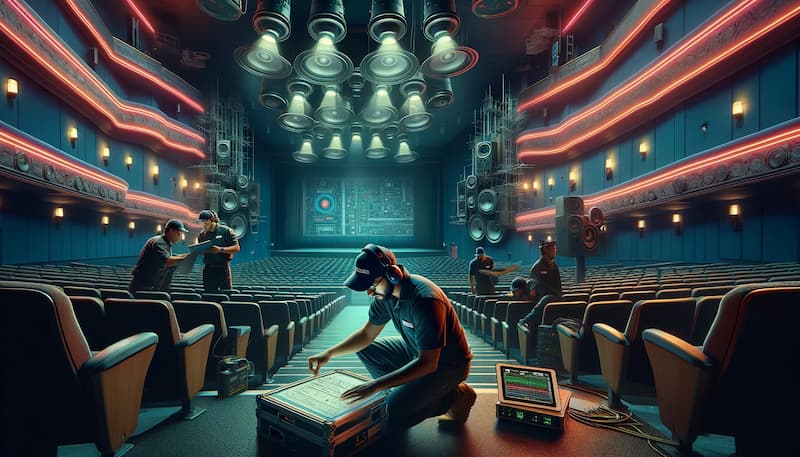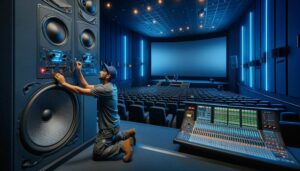
The cinematic experience has evolved dramatically since the days of silent film, with sound emerging as a critical component that deepens immersion and the emotions evoked by cinema. In this context, Dolby Atmos technology has established itself as a revolution in sound design, redefining expectations around the world and setting new standards for the industry.
Dolby Atmos represents the pinnacle of surround sound technology, introducing a new dimension to audio design in cinema. Unlike traditional sound systems, which rely on channels assigned to specific locations in a room, Dolby Atmos breaks those barriers by using an object-based sound approach. This innovative technology allows sound designers and filmmakers to position and move individual sounds to any point in the three-dimensional space of the cinema, including above the audience, creating a richer and more enveloping auditory experience.

At the heart of Dolby Atmos is the idea of treating sounds as individual objects that can be freely placed and moved in a three-dimensional environment. This capability is achieved through an advanced metadata system that accompanies the audio track, indicating the precise location of each sound in space. Dolby Atmos audio processors interpret these metadata in real time, adjusting the sound projected through an array of speakers located around and above the audience to replicate the location and movement of sound objects.
Dolby Atmos brings several key innovations that dramatically enhance the movie-watching experience:
This technology has not only raised the standard for the auditory experience in cinema but has also driven creativity in the industry, allowing creators to explore new narrative dimensions through sound. Dolby Atmos has transformed how filmmakers tell stories, offering audiences a more immersive and emotional experience than ever before.
The main innovation of Dolby Atmos lies in its object-oriented approach to sound. Each sound object can be individually controlled, allowing content creators to position sound anywhere in the room, even above the audience. This capability provides unprecedented immersion, making viewers feel as if they are inside the movie.
The benefits of Dolby Atmos extend beyond mere enhancement of sound quality. The technology significantly improves audio clarity and richness, allows for more precise sound direction, and facilitates a much more immersive and emotionally impactful viewing experience.

The adoption of Dolby Atmos in cinemas represents a significant qualitative leap in how viewers experience sound. However, this advancement comes with its challenges and specific requirements, from installing specialized hardware to adapting rooms to accommodate this technology.
Implementing Dolby Atmos in a cinema begins with a detailed technical assessment of the space. This technology requires the installation of a significantly higher number of speakers, including ceiling speakers for “overhead” sound effects. Unlike traditional sound systems that might use between 5 and 7 audio channels, a Dolby Atmos setup can involve up to 64 individual speakers managed by an advanced Atmos sound processor capable of interpreting and distributing sound objects in real-time.
The system also needs additional subwoofers to handle low frequencies, ensuring that the impact of action scenes is both heard and felt. Every component, from speakers to amplifiers and the sound processor, must be Dolby Atmos compatible and meticulously calibrated for the specific space of the room.
One of the biggest challenges in implementation is physically adapting existing cinema rooms to accommodate the necessary infrastructure. This can include remodeling ceilings and walls to incorporate the additional speakers and ensure optimal sound coverage. The room’s acoustics also play a crucial role, with the need for specific acoustic treatments to prevent unwanted reflections and adequately absorb sound, thus ensuring the purity and clarity of the audio.

Despite these challenges, the advantages of implementing Dolby Atmos are substantial. Cinemas equipped with this technology can offer unmatched sound experiences, making a notable difference against competitors and home entertainment systems. This not only attracts larger audiences but also allows cinemas to justify premium ticket prices for screenings using Dolby Atmos, thereby increasing revenue.
Additionally, Dolby Atmos has proven to be a strong incentive for content production. Filmmakers and content creators are increasingly interested in designing their soundtracks to take advantage of Atmos’s unique capabilities, thus creating a demand for spaces that can offer the complete desired experience.
In the United States and South America, several cinemas have led the adoption of Dolby Atmos, demonstrating the value of this investment. For instance, cinema chains in cities like Los Angeles, New York, São Paulo, and Buenos Aires have reported significant increases in customer satisfaction and attendance, attributing these achievements to the superiority of the audio experience provided by Dolby Atmos.
The implementation of Dolby Atmos in cinemas is a complex process that requires significant investment in technology, structural adaptations, and technical training. However, the result transforms the cinematic experience, elevating sound immersion to unprecedented levels and setting a new standard of excellence in cinema audio. As more cinemas adopt Dolby Atmos, viewers can anticipate a golden age of unforgettable auditory experiences that complement the visual magic of cinema.

Dolby Atmos is paving the way to the future of cinematic sound, influencing not only how cinemas are designed and equipped but also how filmmakers and sound designers approach movie production. As more creators adopt this technology, we can expect to see even greater innovations in cinematic narrative, with sound playing an even more crucial role in creating immersive worlds and memorable experiences.
Filmmakers and sound technicians who have worked with Dolby Atmos highlight its ability to “open new dimensions” in storytelling, allowing sound to flow and move organically around the audience. Specific films, such as big Hollywood productions and international hits from Latin America, have shown how Dolby Atmos can significantly enrich the story, from intense action sequences to subtle dramatic moments.
Dolby Atmos is changing sound in cinema, offering an unprecedented auditory experience that immerses viewers at the heart of the narrative. As the technology continues to evolve and expand to more rooms around the world, its impact on the film industry promises to keep growing, taking the magic of cinema to new emotional and technical heights.













